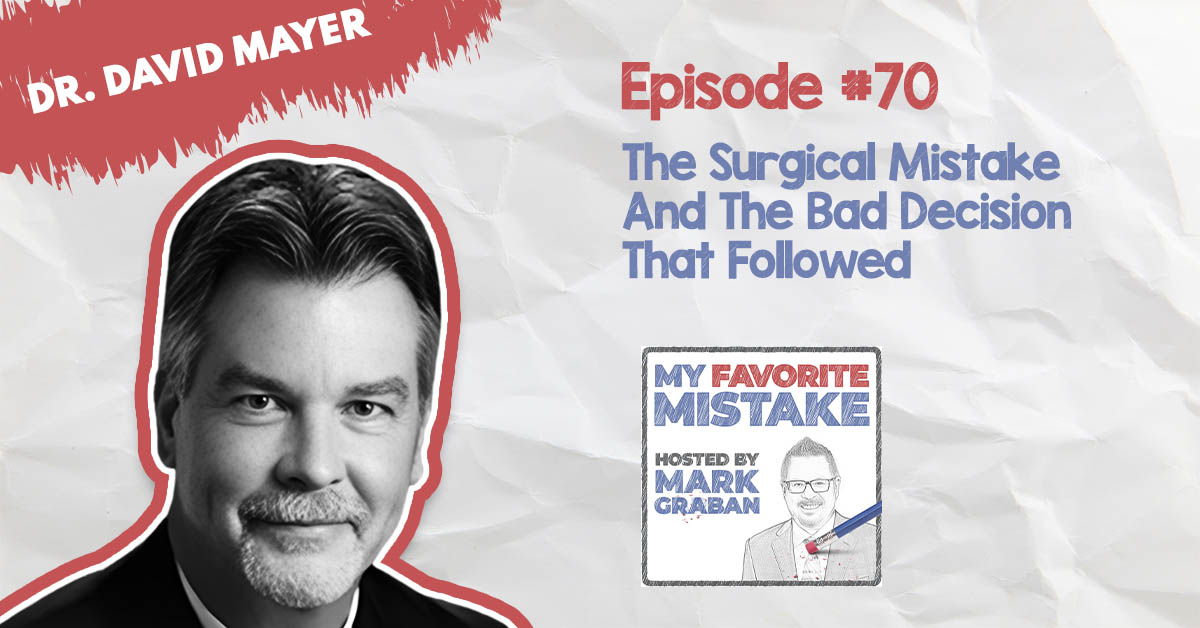Listen:
Check out all episodes on the My Favorite Mistake main page.
My guest for Episode #70 of the My Favorite Mistake podcast is Dr. David B. Mayer. He is both the Chief Executive Officer of the Patient Safety Movement Foundation and Executive Director of MedStar Institute for Quality and Safety.
In today's episode, Dave shares a compelling story from his time as an anesthesia resident. What happened after the surgeon cut into the wrong side of the patient? Was the coverup worse than the crime? What did Dave learn from this incident and the pressure to keep quiet? How has this inspired him to be a patient safety leader?
Questions and Topics:
- Lectures now about how to respond to harm… how do the students react?
- The book Wall of Silence about the harm caused by medical errors
- Patients want the truth – parallels to the Garrison Brothers episode
- CANDOR program
- How do mistakes like this happen?
- Culture? Feeling safe to speak up? Can’t just demand candor?
- Just Culture
- His ZERO hat — How many patients are harmed or killed by preventable medical error each year?
- “Moon Shot?” Video
- What would you do if you were made Patient Safety Czar?
- 1) Committee to talk about the moon shot
- 2) National patient safety authority like NHTSA or aviation
- 3) Incentives better aligned around patient safety & quality
- 4) Transparency
Scroll down to find:
- Video
- Quotes
- How to subscribe
- Full transcript
You can listen to or watch the episode below. A transcript also follows lower on this page. Please subscribe, rate, and review via Apple Podcasts or Podchaser! You can now sign up to get new episodes via email, to make sure you don't miss an episode. This podcast is part of the Lean Communicators network.
Watch the Episode:
Quotes:
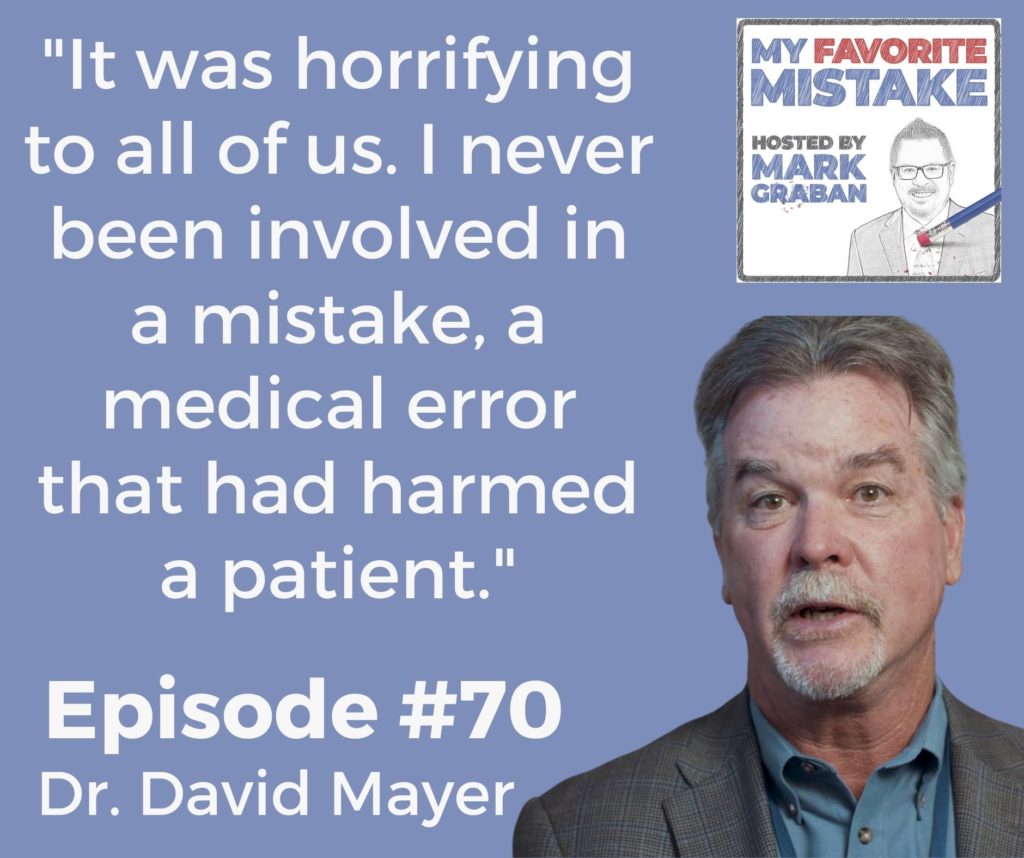
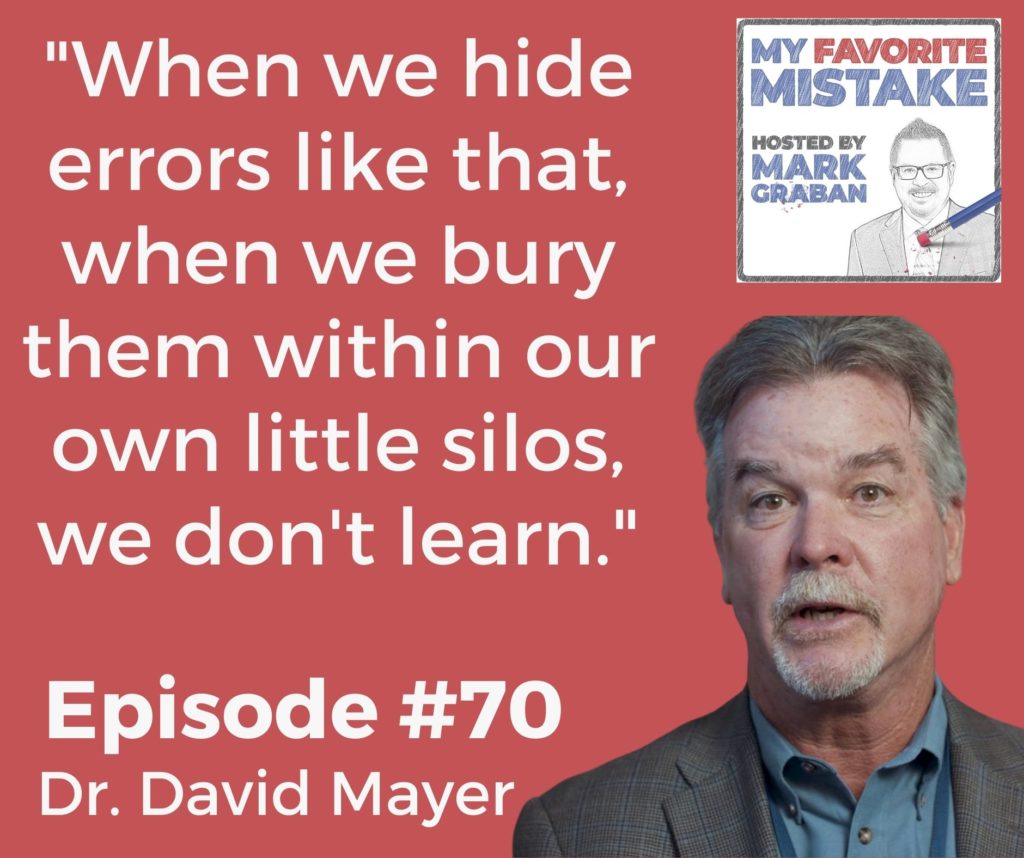
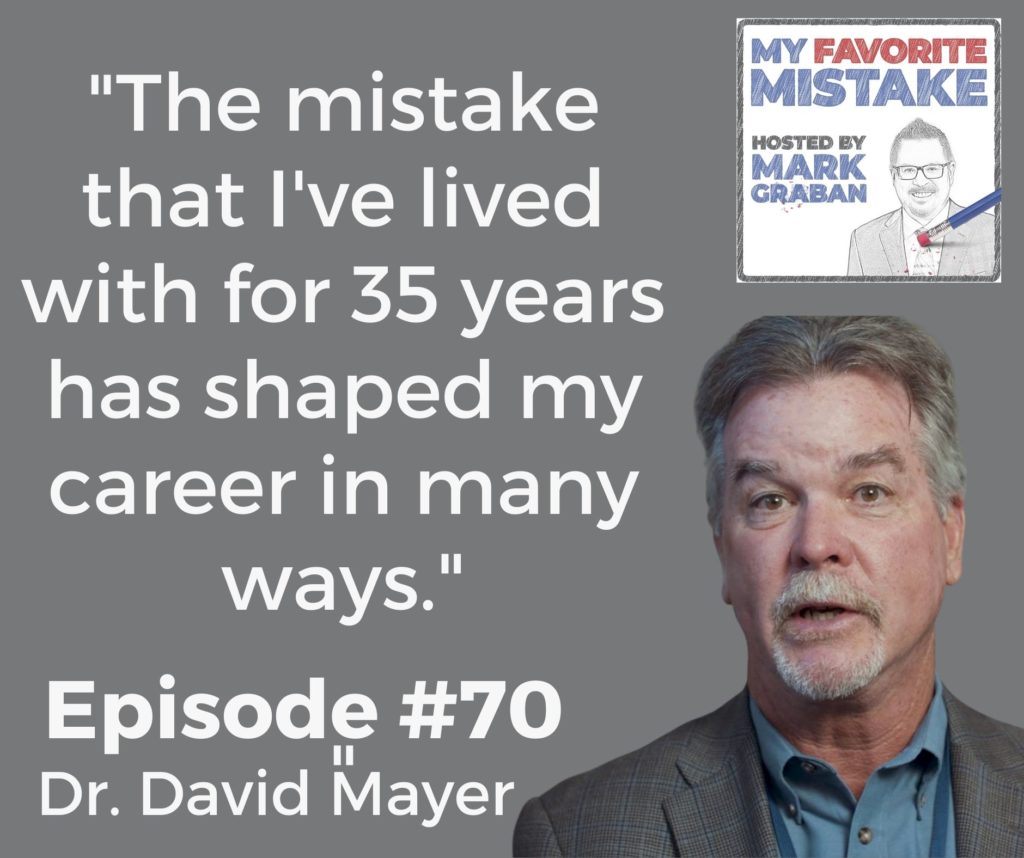
Subscribe, Follow, Support, Rate, and Review!
Please follow, rate, and review via Apple Podcasts or Podchaser or your favorite app — that helps others find this content and you'll be sure to get future episodes as they are released weekly. You can also become a financial supporter of the show through Anchor.fm.
You can now sign up to get new episodes via email, to make sure you don't miss an episode.
This podcast is part of the Lean Communicators network.

Other Ways to Subscribe or Follow — Apps & Email
The Surgical Mistake And The Bad Decision That Followed: Dr. David Mayer
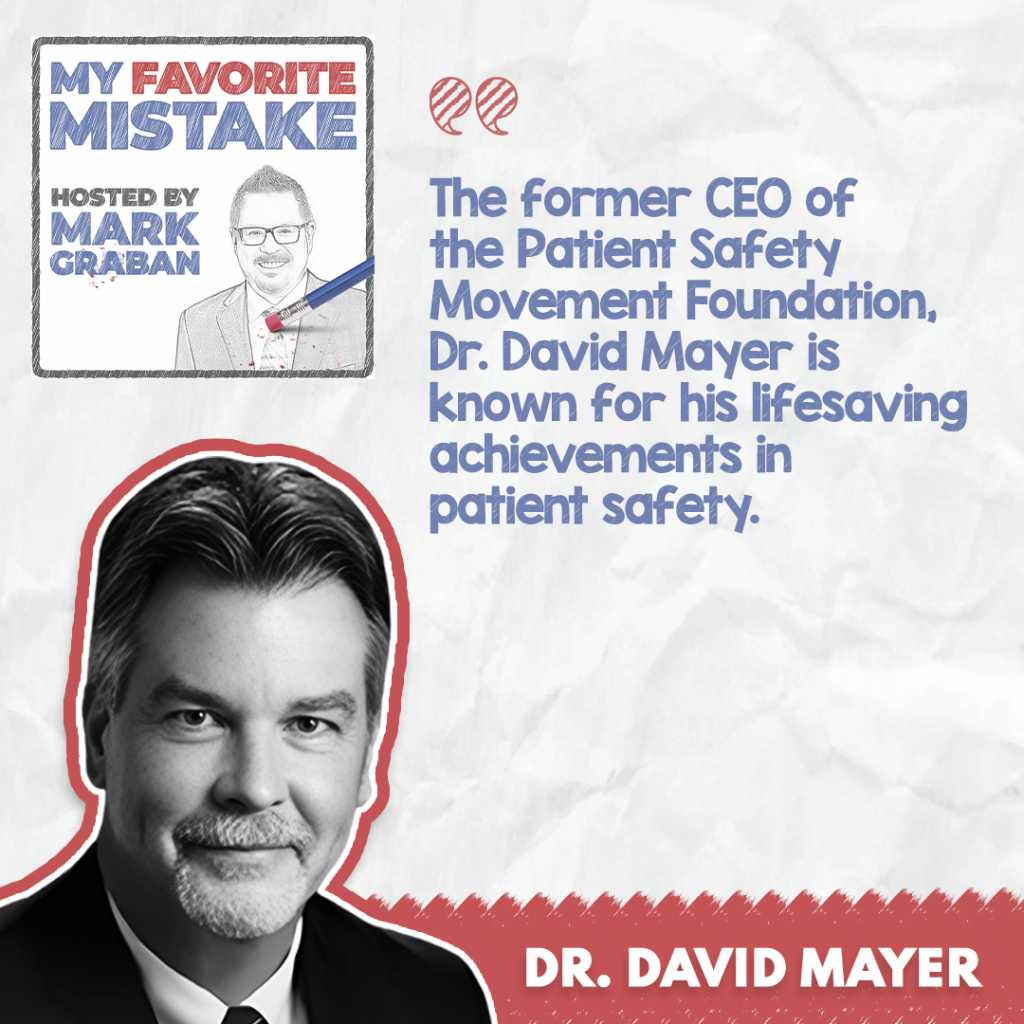
We're joined in this episode by Dr. David Mayer. He is the Chief Executive Officer for an organization, a non-profit called the Patient Safety Movement Foundation. He is also the Executive Director for the MedStar Institute for Quality and Safety. MedStar is a health system. Dave, thank you so much for joining us. How are you?
Mark, it's great to be here.
We're going to hear your story and then we'll talk about the work you're involved in. We'll call this a teaser. For those who are reading, we'll find out later what your hat means. It says ZERO in big bold letters. First off in the category of sharing, if you wouldn't mind, David, could share your story? What do you consider to be your favorite mistake?
I don't know if it's my favorite but it's one that changed my life dramatically and had an impact on the work I have done for the last several years. It involves patient care. As a physician and anesthesiologist in the operating room, I remember being a senior resident and bringing a patient into the operating room for what was to be a right-sided inguinal hernia. I did my thing. I put my monitors on the patient. I made sure the patient was comfortable on the operating room table.
Once we were set to go, I gave my anesthetic drugs. The patient went off to sleep. As soon as I finished my induction and said, “The patient's stable,” the surgical team immediately went into action. They were prepping, draping and getting the room moving because as we know, speed is of the essence. The more cases you can do in an operating room daily, the more profitable the hospital is. We move very quickly into the procedure. We get to the time when the senior surgical resident was getting ready to make the incision. I was in my world doing my things and charting my vitals. Everybody else was in their little silos.
The surgical attending had been detained at the scrub sink by another surgeon on a question of a different patient that they were discussing. Two minutes after the incision was made, the surgical attending walked into the room to the operating table, looked down and said, “I thought this was a right-sided inguinal hernia?” The surgical resident, unbeknownst to me because I wasn't paying attention, made the incision on the left side and had gotten about two minutes into the procedure before realizing the mistake was made.
It was horrifying to all of us. I had never been involved in a mistake, a medical error that had harmed a patient. The surgeon surprisingly was very calm. The resident went shook. The resident had to go sit on the chair in the corner. The impact of making that mistake impacted them. The surgical attending and the intern who was scrubbed in on the case proceeded to close the wound on the left side, go to the right side and fixed the hernia on the right side.
[bctt tweet=”It was horrifying to all of us. I’ve never been involved in a mistake, a medical error that harmed a patient.” via=”no”]
At the end of the case, the patient had two surgical dressings, 1 on the left and 1 on the right. We woke the patient up from my general anesthetic. The patient was very drowsy. I took the patient to the recovery room and I dreaded having to go back there in an hour to discharge the patient. It was our job to discharge the patient once we felt they were stable after the anesthetic. An hour goes by and I get called to the recovery room.
As I'm heading to the recovery room into the bed where my patient's located, I noticed the patient's got a smile on his face and that was not making sense. I get to the side of the bed and before I could say anything, the patient goes, “Today's my lucky day.” I'm deer in the headlight look. I'm confused but as a good resident, I don't say anything. I'm listening. The patient says, “My surgeon discovered under anesthesia I had 2 hernias and was able to fix both of them under 1 anesthetic. It means I only missed one day of work.”
I didn't know what to say. I was shocked. I paused. It seemed like an eternity. It was probably about 5 or 10 seconds. I looked at him and said, “Yes, this is your lucky day,” and I signed that patient out. I still remember that case many years later and his face. He was about 5'11”. He had a Tom Selleck-looking mustache. It impacted my career. I hadn't heard about medical errors. I'd gone through four years of medical school learning all this science and clinical.
I spent almost three years in anesthesia learning all the different anesthetic agents and techniques. No one ever talks about what happens when we make an error. What happens when we harm a patient? I had never had a lecture like that. I also never had a discussion about what we do and how we respond to patients when an error occurs. The hidden curriculum goes into play where you follow the leads of what others do.
The role model that day, for me, if you want to use the term role model, was to deny and defend. It was to lie about it and get away with it. Don't share this. Keep it within our little world. As a resident, it’s the fear of losing my residency, the fear of medical malpractice, what would happen to my license and knowing that I was involved in this case but I was only thinking about myself. I wasn't thinking about what was the right thing to do for the patient, being open and honest. When we hide errors like that and bury them within our little silos, we don't learn.
[bctt tweet=”When we hide errors like that, when we bury them within our own little silos, we don’t learn.” via=”no”]
What happened was for years, we continued to have wrong-sided surgery in healthcare. We still have it because we haven't figured out solutions. We've gotten better with timeouts, checklists and marking the sites but that only started coming because people started talking about their errors. That's why a lot of my career has been focused on trying to understand safety and why we make errors. “To err is human,” as the Institute of Medicine report said but how do we more importantly put systems and processes in place that trap those errors before they occur?
I like to use the analogy that pilots in a research study make about 1 error every 1 hour or 2. They either repeat something wrong. They think they heard something different. It’s little things like that but they have so many processes and systems in place that these errors are trapped before they move forward or potentially lead to a mishap in the cockpit. We're not there when it comes to safety within the environment. That is a mistake that I've lived with for many years but it has shaped my career in many ways.
[bctt tweet=”The mistake that I’ve lived with for 35 years has shaped my career in many ways.” via=”no”]
I appreciate you for being willing to tell that story. There are a lot of follow-up questions that I've got jotted down here. There's so much we can unpack from this specific mistake. Some might say, “It was a mistake. Do not speak up.” I've heard people sometimes get judgmental and say, “That nurse or pharmacy tech should have spoken up. You have an obligation,” but you've already pointed to things like hierarchy and what's sometimes described as a culture of fear.
I wouldn't fault you for not correcting the surgeon or attending to the patient. I would frame it as you being put in a bad position. How do we avoid doing that in the future? That's been a big part of your mission. Can you talk a little bit about trying to change some of that culture, education and the way people are behaving?
That's why I've been so involved in the CANDOR program. It’s Communication and Optimal Resolution. I was fortunate enough. It took me nineteen years to share that story. The first time I shared it was in 2004 in front of a group of medical students. We're going through a patient safety lecture within our curriculum. I was the Associate Dean for the medical school at the University of Illinois. I put a Patient Safety and Quality Care Curriculum, a four-year longitudinal curriculum into the student's learnings while they were with us.
I shared this story for the first time after nineteen years because I had read the book Wall of Silence by Rosemary Gibson the year before. I read this book in a week. It's a great book. It talks about what patients and families want after they've been harmed by preventable medical errors. It's not about root causes or event reviews.
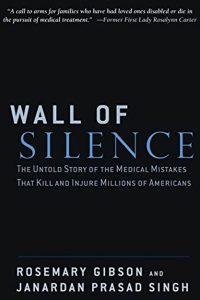
It’s, “What did that family want or what did the patient want from their hospital or their physician?” There were 4 things that all 75 families echo. First, they wanted the truth. They wanted their questions answered. They didn't want to have to run to a lawyer to try to get information that they felt they deserved when an error went in a direction that nobody had anticipated. Its honesty.
The second thing they wanted was an apology when appropriate. If the hospital or that care team had not lived up to the care standards and that harm was preventable, they wanted some empathy and an apology. Third, they wanted a resolution. There are a lot of times issues that need to be dealt with after the fact. Sometimes, it's financial resolutions. As we see in courts of law for care plans and other things, many times we found at the University of Illinois that it was 69 of 75 cases that we use the 7 pillars model. The apology and being open and honest in answering questions were enough.
It wasn't like, “We want $100,000 to make us feel better.” No. Those families moved on. Did they say they never wanted to see us again? Did they share that they never wanted to see our hospital again? Yes, but at least that brought closure to them. Finally, the fourth thing was what are you going to do to improve your hospitals so this doesn't happen to somebody else?
Those were the four things I learned from Rosemary's book. It was something I was looking for in my soul-searching for what I should have done. That became an impetus for me and others at the University of Illinois when we brought Rosemary in to start our seven pillars program, which was one of the programs that eventually led to CANDOR, Communication and Optimal Resolution.
One of the big systemic changes is that the education system for physicians has changed. How consistent is that education about harm, patient safety and medical education?
It's gotten better. It still has a lot of work to do. When I was the associate dean, we always had a saying that assessment drives the curriculum. Students would always say, “Is this on the National Board Exam? Is this on the final exam?” If safety and quality are not embedded within those high-stakes exams, they're not going to study or pay attention to it. You're going to think it's something that isn't important.
It's the anatomy, the biochemistry and the congestive heart failure algorithms that they're going to get tested on. We still have a long way to go. I will say that the ACGME on the residency side has been pushing this and training within residency programs has become a lot better but we still haven't taken it down into the medical and nursing schools the way we should.
How did the students react when you told that story? Did they react the way you expected? What did you predict?
They were somewhat shocked. It was very quiet in the room. I was opening up and sharing that but remember that students, especially in the first couple of years, are very clinically naive. They haven't been on the floors of hospitals. They haven't seen things that go on. The students start with such a great mindset wanting to always do the right thing. In the clinical environments, the world that they get into like me shows, “No. That's not the way we handle these things here.”
We turn it over to our legal counsel and they put up roadblocks. They tried to not share the medical record with the family. It becomes a legal battle and that was wrong. We found out through the seven pillars and CANDOR work that not only is open and honest approaches to preventable medical harm but the right thing to do. It's also the smart thing to do because you're able to come to a resolution quicker. You're able to close the events and allow the family and the care team to move on.
What a doctor or nurse wants to go through sometimes are 5, 6 or 7 depositions over a few years before the case finally gets to court. Everybody's still arguing about right and wrong. I remember Rick Boothman had a great comment. Rick's out of Michigan and did a lot of great work in this area. He was a trial lawyer and was on the plaintiff's side, as well as on the defense side for medical malpractice cases.
He said in the many years, he would be in the courtroom, not once did anybody ask, “What did we learn from this?” It was all about who would win and what dollars were being saved or having to be dispensed in resolution. There was no learning involved in our medical legal system and that's why we make the same errors over and over. You can't learn unless you're transparent.
I want to come back to a little bit of question about common errors, harm and death but first, talk about students. I come at this as a non-clinician who has been fortunate to work with healthcare organizations. Years ago in San Antonio, there was a great program there where it's a bridge from high school into college. You've got students. It's called Alamo Academies. I had a chance to come in and lead a session about healthcare improvement. You have kids in the class. You have a wide range of aspirations.
You have some who want to be pediatric neurosurgeons. You also have some that want to be a laboratorian, a nurse or whatever points in the health system. I wanted to bring up the idea of medical error and preventable harm. I shared an example. It was news about a wrong-side surgery. It was similar to what you were talking about. Their jaws dropped. I could see from the looks on their faces that they were thinking, “How could this happen?”
I tried to ask them, “How do you think this could happen?” It was amazing how intuitive the kids were. The first hands that were raised said things like, “I bet there was some miscommunication or maybe somebody got distracted.” I was going to turn that question back to you. How do these mistakes happen in an operating room in particular?
I love the story of students. I remember when I would start the curriculum, the first day at 8:00 in the morning, after the new student week and all the parties, they were there. Before the first biochemistry lecture, I did an introduction to medical school lecture. I would ask the students, “You're in here. You did all the work. You got the test scores. You went through the interviews. Now, you are in medical school. What are you most afraid of?
For 5 years straight, the 2 things that they always brought up was fear of failure. “I’m in here and I don't want to fail. I don't want to have to go back and tell mom, dad and my friends that I couldn't cut it.” Also, the fear of hurting somebody. They have seen and heard stories. They are very intuitive but errors occur because we're so busy.
Let’s say in the operating room situation. There's the pressure to turn rooms over quickly or move quickly. We're doing many lateral-type cases. In 1 room, we may do 5 hernias or 5 knee arthroscopies in a row. The first one might be left. The next two might be a right and a left and a right. The schedule sometimes makes a mistake and is posted wrong. The consent sometimes has the wrong information.
That's why sometimes patients get frustrated when we continue to ask them 5 or 6 times, “We are operating on your left knee. Is that correct?” The patient is like, “Why do you keep asking me that?” It’s because we've learned all it takes is one person to catch something that could prevent an error from happening. It's the pressures of the still volume of cases we do versus the quality of cases we do that are reimbursed.

The last thing I'll add about the students is one of the things I'm probably most proud of. Many years ago, I founded what was called The Telluride Patient Safety Summer Camps for students and residents. Surprisingly, who was the one that was funding this scholarship-wise was medical malpractice companies. It was The Doctors Company out of California and COPIC out of Denver.
They wanted the next generation of physicians, nurses and healthcare leaders to understand not only the importance of safe, high-quality care. If we spent 4.5 days with these students in Colorado, we would have every year about 200 students go through. We've got alumni of almost 1,400 students and residents that have gone through our 1-week workshops over the last several years.
There's a big segment of it in being open and honest after preventable harm. I share that story of mine with the wrong-sided surgery and how I did it wrong. We have some patients and families where it's been done right and they're part of our faculty in these Telluride Summer Camps for the students. They loved learning from the family members as faculty.
When you talk about those multiple checks, some other practices seem to have become more common things that I would call mistake-proofing of signing where the incision is going to take place with the Sharpie. The surgeon signing their name as part of something can mean to double-check because once the patient's been put under anesthesia, you can no longer ask them, “Why are you here?”
As a patient, I would say, “There's a barcode. There's a thing around my wrist. You're supposed to be able to track why I'm here,” and not rely so much on the asking. There are some of those other approaches that are meant to take away what seemed like systematic causes of error. It's not a matter of bad people. It's a bad system it seems.
No one goes to work to harm a patient. We all go to work to heal a patient. We're devastated when we're involved in an error that has reached the patient and potentially caused harm. There are good people. We just haven't given them the systems, the processes, the resources, the tools and sometimes the training to work together effectively as a team.
Learning how to communicate better and giving them those different types of tools that help communication processes so we don't have breakdowns between five different people from social work to pulmonary consultants to internal medicine. We have so many people taking care of a patient. If they're not communicating effectively, that's where breakdowns occur.
You brought up the point that if people are rushed, they're under time pressure and things have fallen behind due to factors out of their control, we don't want people to be pressured into cutting corners. It might be too harsh. Being rushed is perhaps more prone to mistakes.
I remember being at an airport in Denver waiting to get on a plane and they said the plane was going to be delayed for 45 minutes. The reason the plane was delayed was that one of the windshield wipers on the window needed to be replaced. They made sure that they did that even if it meant a 45-minute delay and getting people a little disappointed.
When I heard why there was a delay, I was giving thumbs up and saying, “Thank you.” I'm not sure if we do that in-house care all the time. It's a small little thing that we figured out, “Don't worry. We probably won't need it anyways. Let's get the patient in the room.” I've seen that happen too many times and that's a different mindset than maybe aviation has come to have.
In aviation, the pilot’s safety is more directly aligned with the passengers. That might be a difference as well.
It might but I remember a pilot telling me that one time on a panel. We finished the panel. We were sharing thoughts. This is about a few years ago and he told me, “Do you know why healthcare will never get this? It is because the pilot is the first at the scene of an accident.” It kicked me in the gut a little bit. I was saying to myself, “Is that true?” The people I've worked with want to do the right thing. They want to make sure the patient is safe as best they can. It's just that the things around them sometimes limit them from doing the job that they came to work to do that day.
It might be an unfair assumption that I made there. If that was a mistake, forgive me.
You're not the only one. I hear that a lot and there may be some truth to it but the people I've worked with are not cutting corners. We need better systems and processes.
It might be some of the issues. I asked the question directly. I didn't use the crutch of like, “Some people would say.”
You are right. That's what I'm saying about the windshield wiper. I'm not sure a lot of us would say, “Let's wait for 45 minutes.” We'd say, “What's the chance of anything happening. We never use that piece of equipment anyways,” versus the mindset of aviation.
It seemed like there are two different types of mistakes we've been talking about. There's the medical mistake and then there's what could be framed as the mistake of not being honest with the patients. One other question about the culture is it seems unfair to lecture people, “You must speak up.” What is being done? What do you think is a best practice that you’d like to see happen within a health system? Are there ways that people in more senior positions can remove some of the fear or break down some of the hierarchy that might prevent people from speaking up when they would want to?
It does start at the highest levels. You've got to have leadership, including the CEO and a board that supports that. One of my favorite stories is about a good friend of both of ours, Paul O'Neill. He used to say at Alcoa, “I'm not upset if something goes wrong because things happen and we've got to learn to fix them. What I would be upset about is if I don't get it reported to me immediately. If I hear about it 1 day or 2 days later, that's when I'll be upset.” The CEOs have to walk that walk also in hospitals. You got to say, “I've got your back.”
That's what I used to say when I was the Vice President of Quality and Safety at MedStar to people. I said, “I've got your back. If there's something that happened, you could come to me and share it with me. I've got to protect it because we need to learn. We need to engage the patient or the family member in a conversation.” It's critical. When you look at great places across the country, it’s Cincinnati Children's or Virginia Mason. I could go to Mayo. They've got that culture that starts there.
It's the same thing with our CEO, Ken Samet at MedStar. Ken was the real deal. That's why we've done some tremendous work at MedStar around quality and safety. We were involved in some of the disclosures we would have with family members, even though he wasn't part of the care team. He wants to be there for those communications. That's how seriously he took it.
It seems like one of the high-level lessons culturally is that blame and punishment get in the way of learning, which then hampers our progress toward reducing medical errors. That is something like the conundrum of the blame. The blame and punishment to some people might seem necessary or the right thing to do but it seems counterproductive.
Yes, but in many ways, hospital science is the easy way out. If you could blame a nurse for something that any nurse might've made or a physician for a mistake that any physician might've made in the same situation, you solved the problem in your mind. You suspended the nurse or dismissed the physician. It's easy. Let's go on. They think the public is okay. The family would be okay with it. It doesn't work the way it should. There have been numerous examples of that happening and the culture of that hospital being destroyed.
There are cases where people have knowingly and recklessly violated safe policies for their benefit. Some caregivers have done that. Those people need to be held accountable. In Just Culture, you have to look at the safety science when something goes wrong and understand what happened. “What was the problem? Who was the problem?” However, the opposite side says you also need accountability. When somebody is reckless and knowingly went out of their way to do something that put a patient at risk, we need to hold them accountable and act on those.
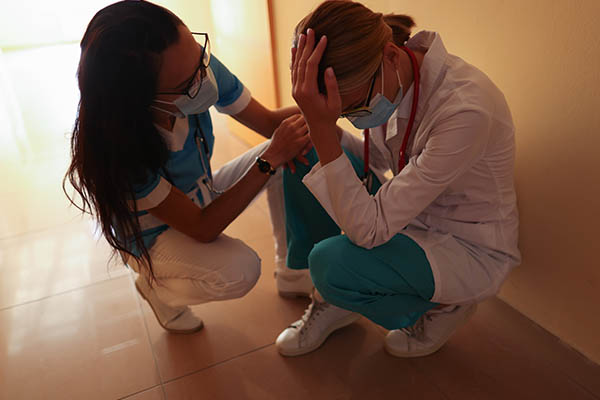
There's a difference between a mistake and an intentional act, for sure.
There's a whole science around this and some things require coaching. I'm thinking, “Why aren’t we getting the team together and figuring out what happened and putting new processes or systems in place that would prevent it from happening again?” Once you cross that line into something being very well-intentioned, that's where you were talking about the difference in making an error which 99.9% of the time is good people trying to do the right thing but something is going wrong with the system or process breakdown.
The 1st error is unintentional but the 2nd error like lying to patients or hiding those mistakes is intentional. That is pretty well-resourced and very well-thought-out. You line up your legal counsel and use the deny-and-defend approach. You say, “We're going to defend this,” even though the error is indefensible. “We'll figure out a way to beat this in court.” That's wrong because that harm could be equally as bad if not sometimes worse than at first physical unintentional harm.
Before we wrap up, I want to talk about your hat that says ZERO in big bold letters. I was about to say, “Let's talk numbers,” but that's not the right way to frame it because each incident of harm or death is somebody's life. I don't mean to call it the numbers but when we talk about the preponderance of how many patients are harmed or killed by preventable medical mistakes or medical errors, it's a non-zero number. How big roughly is that number? How big of a gap is there between that reality and a goal of zero harm?
It's a number that's been debated. If you go back to the Institute of Medicine, they say it’s as high as 98,000 patients. There was work done by David Clawson and others using the Global Trigger Tool that said the errors and the preventable harm events might be ten times higher than we originally thought. You get John James's paper and research that said it could be as high as 440,000. The most recent was the Makary study in the British Medical Journal that showed 251,000 patients die from preventable medical issues. That made it the third leading cause of death in this country on an annual basis.
The pandemic said over 400,000 but on an annual basis over the last several years, preventable medical error has been the third leading cause of death in this country. We always say the number is 100,000 or 1 million but as long as it's greater than zero, it's too many. No one in aviation would set a goal that says, “We'll be happy if we only have two plane crashes this year.” No. They strive for zero and that's my hat at the Patient Safety Movement Foundation. We are committed to zero preventable deaths by 2030 and we want people to have the urgency. We want to raise the stakes on this statement.
I've been talking about why not create a Patient Safety Moonshot. President Kennedy did it in 1960 when he said, “We're going to put a man on the moon by 1970.” We've also said as the new President Biden was sworn in that he was put in charge of the cancer moonshot. Before President Obama left office, he said, “We are going to cure cancer in ten years.”
He claimed that it would be the cancer moonshot. Why not a Patient Safety Moonshot? Why not say, “Enough is enough. We are going to do whatever it takes,” be it forming the National Patient Safety Authority, increasing transparency or realigning incentives but we are going to do whatever it takes to drive and get to zero preventable harm by the end of this decade.
I'd love to see the new administration as well as others embrace that concept. If we don't hit zero, I guarantee we'll still be so much better. We'll be closer to aviation where mishaps are so rare that they go years without significant harm happening. Let's drive for that because as we say at the Patient Safety Movement, one is still too many.
You mentioned Paul O'Neill and that was certainly his view when he was the CEO at Alcoa. The goal was zero employee harm. He would say, “Zero is the only defensible goal.” When we talk about the gap, whatever the numbers are, that non-zero number, you talk about transparency or this tendency to lie or cover things up.
To me, there's this catch-22. We have these different studies that estimate and extrapolate out more broadly. I hear some people in healthcare try to shoot that down and say, “Those estimates are wrong.” Part of me gets a little upset and is like, “The estimates wouldn't be so bad if we had transparency.” It's frustrating who's on first back and forth, it seems.
Fortunately, we are getting better. The technology is being applied to the electronic health record using things like automated global triggers that at a moment's notice in real time are able to pick things out of an electronic health record that raise an alert about a potential issue or harmful event that is starting to occur like misdiagnosis and delayed responses to things. Some great work is being done by a number of groups out there. If we use these new technologies and put teams in place that can respond to these issues quickly versus 24 hours later, we'll start seeing a lot of these things happening.

We may not have all the solutions now. Ventilator-associated pneumonia is pretty much down to zero, central line infections and the great Keystone Project work. We may not know how to get Clostridium difficile infections down to zero but if we put our minds to it and put smart people focused on it, we may have that solution. We've got to think positively. Just because we don't know something doesn't mean in five years, we won't have a solution that makes care safer in that area.
As we work towards ZERO, you mentioned the hat. I don't have it handy but I went and purchased one of those hats at the Patient Safety Movement Foundation website. PatientSafetyMovement.org is the website. It's not only a hat store. There's a lot of great information out there.
There are a lot of actual patient safety solutions that are evidence-based tools that have been proven to save lives in hospitals that have implemented them. We also have hats for ZERO if you want to join the mission with us.
It's a conversation starter because you can wear that hat and be like, “Do you think you're a zero?”
Is this a personal identity thing or a character trait?
There's so much work to be done. You mentioned the moonshot, Dave. I saw a video that was released by the Patient Safety Movement Foundation meant to spark thought and some inspiration. We've talked a lot about what leaders, physicians and healthcare organizations can do. You mentioned President Biden. I saw him speak when he was then a Vice President at one of the Patient Safety Movement Foundation's annual events.
I was impressed too. He seemed quite knowledgeable about the Patient Safety Movement and the need for it so his knowledge and passion were strong. Let's say policy solutions are there or if you had a magic wand or you were made the Patient Safety Czar, what could or should be done in the policy realm to help here?
Mark, I agree with you about the new president that we have and the new administration. I've heard President Biden talk many times on healthcare and I've been amazed at his understanding and knowledge. That's achieved not only from all the work he's done as a Senator and then as the Vice President but also through his issues with his first wife, the car crash and then the loss of his son, Beau Biden, due to brain tumor. He gets healthcare, not only from a legislator but as a user of the system.
I'm excited that we will hopefully have these conversations but if I had a magic wand, I'd asked for three things besides putting a committee together that would start looking at this patient's safety moonshot and try to do as he did with cancer. Bring experts together and start finding an agenda and an action plan but I would hope that would include first the formation of a National Patient Safety Authority, an organization similar to the National Transportation Safety Board that exists for transportation and particularly, aviation to learn and disseminate learnings so all could improve.
I would love to see incentives being much more aligned around quality and safety of care. We still reward volume and productivity versus quality and safety and outcomes. That needs to change if we're going to see improvements. Finally, the transparency area that more hospitals are rewarded for embracing the CANDOR-type approach of open and honest communication.
They're sharing their outcomes more transparently so patients and families can make informed decisions about where they might want to go get their knee repaired versus where they may need to get their diabetes treated. Some hospitals are good at one thing but not so good at the other. Patients and families need to have that transparency, not only when errors are made but also about a hospital's current outcomes and things that are done to improve the work in those areas.
In my exposure to the health system, there are incentives based on patient experience or patient satisfaction surveys that drives a lot of attention to those issues. It seems like what you're saying is a similar focus on safety and harm would be beneficial.
With those incentives, we've moved with the pay for performance and some other things that have been implemented but it hasn't been enough. We need to catalyze that effort and make many more outcomes, not only on safety and quality aligned incentively and rewarded for the efforts being put into them.
Dave, thank you so much for taking your time, being a guest and sharing your thoughts. Our guest is Dr. David Mayer. Among other things, he is the CEO of the Patient Safety Movement Foundation. You can learn a lot more online by going to their website, PatientSafetyMovement.org. Thank you again so much for sharing, not just your story but talking more broadly about mistakes and what we can do to help reduce that in healthcare. It’s a very important discussion.
Thanks for having me on, Mark. It’s so great sharing our mission and being part of wanting to get to zero preventable harm. We appreciate all that you're doing to make it happen.
Thank you. We get fired up. We'll go get back to it.
Yes, we will.
—
Thanks to our guest, Dr. David Mayer from the Patient Safety Movement Foundation. I hope this show inspires you to reflect on your mistakes and how you can learn from them or turn them into a positive. I've had readers tell me they've started being more open and honest about mistakes and their work. They're trying to create a workplace culture where it's safe to speak up about problems because that leads to more improvement and better business results.
If you have feedback or a story to share, you can email me at MyFavoriteMistakePodcast@gmail.com. Our website is MyFavoriteMistakePodcast.com. Since every show asks you to do it, it would be a mistake if I didn't ask you to please follow, rate and review but most importantly, thank you for reading.
Important Links
- Patient Safety Movement Foundation
- MedStar Institute for Quality and Safety
- CANDOR
- Wall of Silence
- Just Culture
- Video – Moonshot
- ZERO
- MyFavoriteMistakepodcast@gmail.com
- Dr. David B. Mayer
- Garrison Brothers Episode – Past Episode
- https://Anchor.fm/Favorite-Mistake/Support

